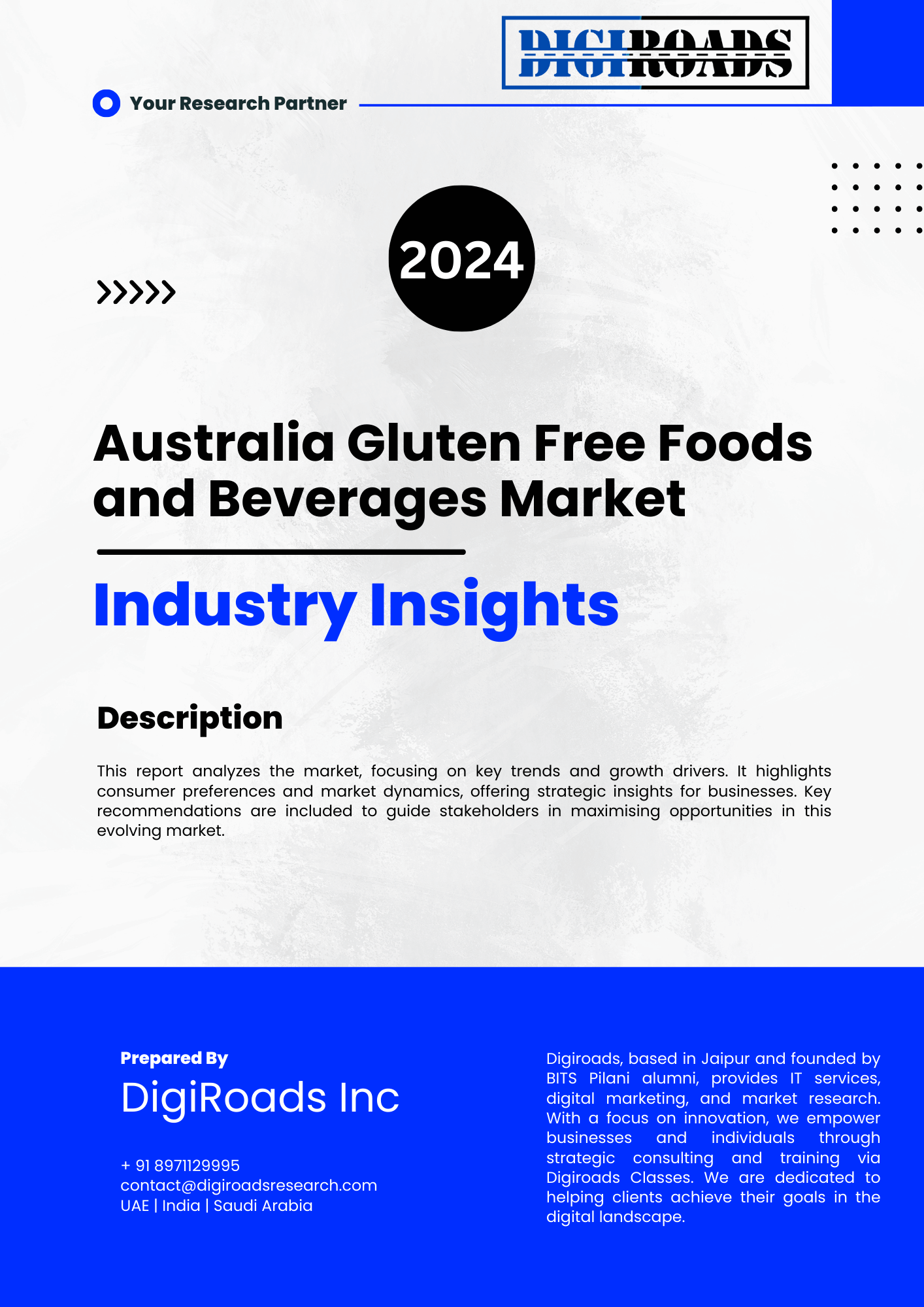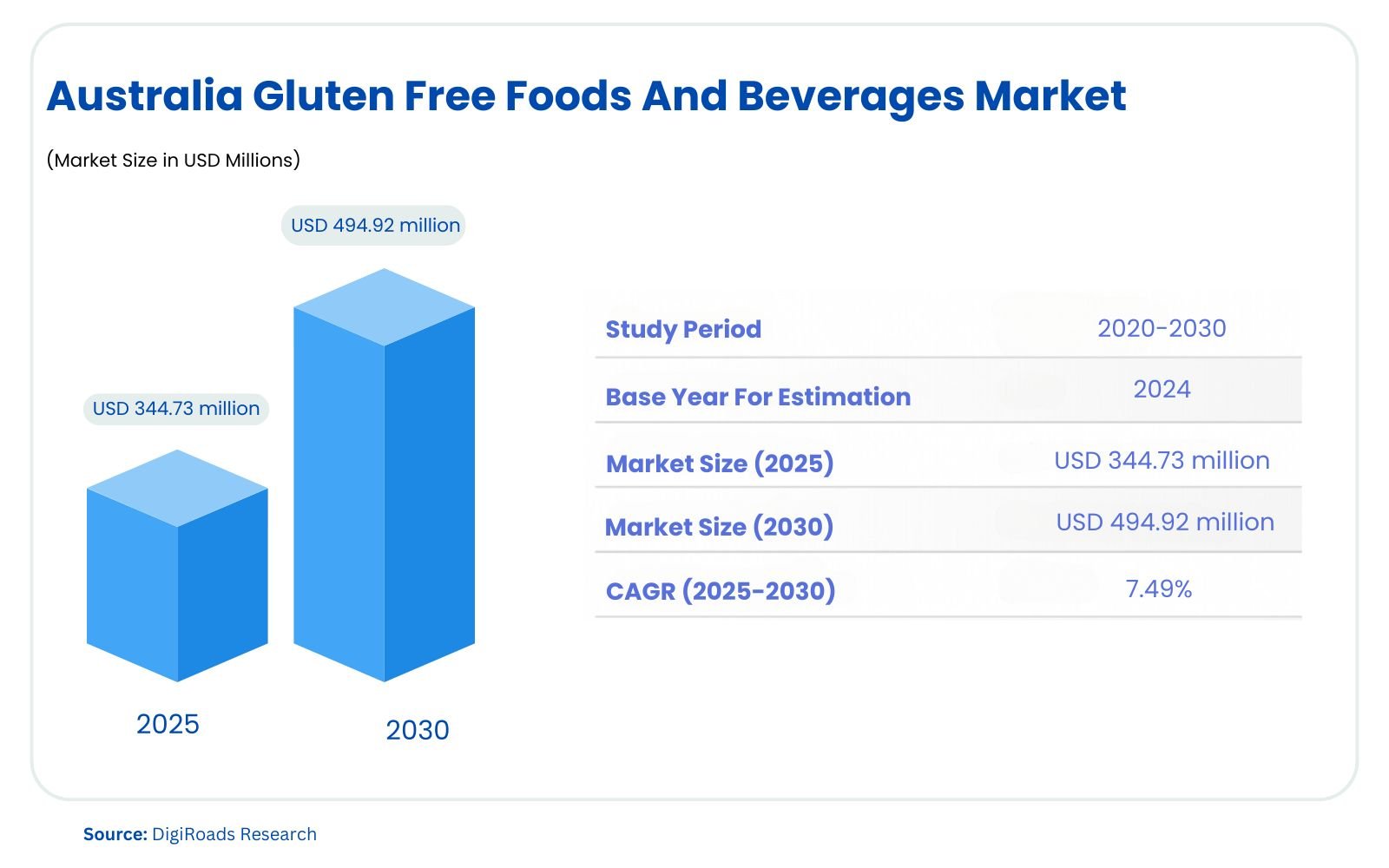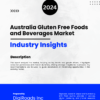No products in the cart.
Australia Gluten Free Foods and Beverages Market
- Brand: DigiRoads
Discover the 100+ page report on the Australia Gluten Free Foods and Beverages Market, providing insights into trends, growth drivers, and the competitive landscape. Available in PDF and Excel formats for easy access to detailed data and analysis.
Category: Food and Beverage
Brand: DigiRoads
Australia Gluten Free Foods And Beverages Market Report | Market Size, Industry Analysis, Growth Opportunities, & Forecast (2025-2030)
Australia Gluten Free Foods And Beverages Market Overview
The Australia gluten free foods and beverages market is on a strong growth trajectory, with an estimated market size of USD 344.73 million in 2025. It is expected to reach USD 494.92 million by 2030, expanding at a CAGR of 7.49% during the forecast period 2025-2030. The Australia Gluten Free Foods and Beverages Market is set to experience significant growth between 2025 and 2030, driven by increasing consumer demand for gluten-free alternatives. Rising awareness about celiac disease and gluten intolerance, along with a growing health-conscious population, is propelling the market forward. Approximately 1 in 70 Australians are affected by celiac disease, highlighting the need for specialized gluten-free products. The market is further supported by the rising popularity of clean-label products and the growing adoption of gluten-free diets by both individuals with dietary restrictions and those seeking healthier lifestyles.
The market includes a variety of products, such as gluten-free bakery items, pastas, cereals, snack foods, meat products, and beverages. Supermarkets, hypermarkets, specialty stores, and online retailers are the key distribution channels, making these products widely accessible. The demand for gluten-free bakery products, including bread and crackers, is particularly high. Major players in the industry, including Sanitarium Health and Wellbeing Company, General Mills, and Kellogg, are investing in product innovation and expanding their offerings to meet the growing needs of consumers.
This report provides a comprehensive analysis of market trends, segmentation, and competitive landscape from 2025 to 2030.
Market Report Coverage:
The “Australia Gluten Free Foods And Beverages Market Report—Future (2025-2030)” by Digiroads Research & Consulting covers an in-depth analysis of the following segments in the market.
| By Product Type | Bakery, Pizzas & Pastas, Cereals & Snacks, Meat, Beverages, Other |
| By Distribution Channel | Supermarkets, Convenience Stores, Specialty Stores, Online Retail, Other |
Study Assumptions and Definitions
The study on the Australia Gluten Free Foods and Beverages Market for the period 2025-2030 is based on comprehensive research, data analysis, and market trends, ensuring an accurate and reliable forecast. The study assumes that the market will continue to grow due to rising awareness about gluten intolerance and celiac disease, along with increasing health-consciousness among Australian consumers. It is also assumed that the demand for gluten-free products will remain strong, fueled by the growing preference for clean-label, organic, and nutritious foods.
The market definitions include gluten-free food and beverage products that exclude gluten, a protein found in wheat, barley, rye, and triticale. These products cater to individuals with celiac disease, gluten intolerance, and those adopting a gluten-free diet for general health purposes. Product categories covered in the study include bakery products, pizzas, pastas, cereals, snacks, meat products, and beverages.
The study focuses on key distribution channels such as supermarkets, hypermarkets, specialty stores, and online retail platforms. Market players, including Sanitarium Health and Wellbeing Company, General Mills, and Kellogg, have been considered in the competitive landscape. The forecast period of 2025-2030 assumes stable economic conditions and consumer behavior trends, with no major disruptions expected.
Market Scope
The scope of the Australia Gluten-Free Foods and Beverages Market report spans a comprehensive analysis of the market trends, drivers, challenges, and opportunities from 2025 to 2030. It covers a wide range of gluten-free products, including bakery items, pizzas, pastas, cereals, snacks, meat products, and beverages. The study also focuses on key distribution channels such as supermarkets, hypermarkets, specialty stores, and online retail platforms.
The report examines the impact of rising gluten intolerance and celiac disease prevalence on consumer demand, alongside increasing awareness of health and wellness. Additionally, it highlights product innovations, clean-label trends, and shifts in consumer behavior toward healthier, gluten-free alternatives.
Key market players, including Sanitarium Health and Wellbeing Company, General Mills, and Kellogg, are analyzed in terms of their strategies, market share, and competitive positioning. The study offers valuable insights into market segmentation, growth forecasts, and industry dynamics, providing stakeholders with actionable data for strategic planning in the gluten-free sector.
MARKET OUTLOOK
Executive Summary
The Australia Gluten Free Foods and Beverages Market is poised for significant growth between 2025 and 2030, driven by increasing awareness of gluten intolerance and celiac disease, along with rising health consciousness among consumers. Approximately 1 in 70 Australians are affected by celiac disease, a condition that requires individuals to adopt a gluten-free diet, creating a steady demand for gluten-free food products. Additionally, there is growing consumer recognition of the health benefits associated with gluten-free diets, contributing to a broader adoption of these products beyond those with dietary restrictions.
The market is segmented by product type, with bakery products (such as gluten-free bread, crackers, and cakes) dominating the sector. Other product segments, including pizzas, pastas, cereals, snacks, meat products, and beverages, are also experiencing growing demand as more consumers seek gluten-free alternatives. Distribution channels include supermarkets, hypermarkets, specialty stores, and online retail platforms, making these products increasingly accessible to consumers.
Key trends driving the market include clean-label products, the rise of organic and whole-grain gluten-free options, and the growing popularity of gluten-free diets as a lifestyle choice rather than a medical necessity. Product innovation and the expansion of gluten-free options by major companies, such as Sanitarium Health and Wellbeing Company, General Mills, Kellogg, and QuestNutrition, are further fueling market growth.
With a projected CAGR of 7.49% from 2025 to 2030, the Australian gluten-free market is expected to witness robust growth. Companies are actively investing in product development, strategic expansions, and partnerships to meet consumer demand and strengthen their market presence. The competitive landscape is fragmented, offering ample opportunities for new entrants and established players to capitalize on the increasing consumer preference for gluten-free foods and beverages.
COMPETITIVE LANDSCAPE
The Australia Gluten Free Foods And Beverages Market is moderately fragmented, with regional and multinational players competing fiercely for market share.
Key Market Players
- The Sanitarium Health and Wellbeing Company
- General Mills, Inc.
- Kellogg Company
- QuestNutrition
- Unilever
- Bob’s Red Mill Natural Foods
- Genius Foods Ltd
- Two Bays Brewing Co.
Market Share Analysis
The market share analysis of the Australia Gluten-Free Foods and Beverages Market highlights the competitive landscape, where several prominent players dominate key segments. The market is fragmented, with both global and local brands competing for consumer attention. Major players such as The Sanitarium Health and Wellbeing Company, General Mills, and Kellogg Company hold a significant share, largely due to their extensive product offerings, strong brand recognition, and wide distribution networks across supermarkets, hypermarkets, specialty stores, and online platforms.
Sanitarium Health and Wellbeing Company is one of the leading players, with its well-known gluten-free product line, including breakfast cereals and other packaged foods. General Mills and Kellogg have also successfully captured substantial market share by launching gluten-free versions of popular products like cereals and snacks, which cater to both health-conscious consumers and those with specific dietary needs.
QuestNutrition and Unilever have established a presence by offering specialized gluten-free products, capitalizing on the growing trend of clean-label and organic food items. Smaller but emerging players like Bob’s Red Mill Natural Foods and Two Bays Brewing Co. are contributing to the expansion of niche gluten-free segments, including gluten-free snacks and beverages.
Overall, the market remains competitive with a mixture of established brands and new entrants focusing on product innovation and meeting the increasing demand for gluten-free foods and beverages. The growing consumer awareness of gluten-related health issues and the popularity of gluten-free diets continue to drive market dynamics.
MARKET DYNAMICS
Market Drivers and Key Innovations
Market Drivers
Several factors are driving the growth of the Australia Gluten-Free Foods and Beverages Market. The primary driver is the increasing prevalence of celiac disease and gluten intolerance. Approximately 1 in 70 Australians are affected by celiac disease, which requires individuals to follow a strict gluten-free diet, creating a consistent demand for gluten-free products. Additionally, about 11% of Australian adults follow a gluten-free diet for various health reasons, further expanding the consumer base.
The growing awareness of the health benefits of gluten-free diets is another significant driver. Many consumers perceive gluten-free foods as healthier, even those without gluten sensitivity, contributing to the mainstream popularity of gluten-free products. The rise in demand for clean-label products, with consumers seeking healthier alternatives that are free from artificial additives, preservatives, and gluten, also supports market growth.
Key Innovations
Innovation plays a crucial role in shaping the market. Major companies are focusing on creating gluten-free products that are not only free from gluten but also cater to other health-conscious consumer preferences. There has been a rise in gluten-free options made with organic and whole-grain ingredients, such as quinoa, chia, buckwheat, and lupin. These ingredients offer nutritional benefits and appeal to health-savvy consumers.
Additionally, manufacturers are investing in enhancing the taste and texture of gluten-free products to match traditional options, which was a significant barrier in the past. For instance, companies like Kellogg and General Mills have launched gluten-free cereals and snacks that maintain familiar flavors and appeal to a broader audience. With these innovations, the market is attracting both consumers with dietary restrictions and those adopting gluten-free as part of a healthier lifestyle.
Market Challenges
- High Product Costs: Gluten-free products are often priced higher than their gluten-containing counterparts, which can limit their accessibility to a broader audience, especially in price-sensitive markets.
- Limited Availability of Gluten-free Ingredients: Sourcing gluten-free ingredients, especially organic and non-GMO varieties, can be challenging and expensive. This impacts production costs and the availability of products in the market.
- Taste and Texture Issues: Despite advancements, some gluten-free products still face challenges in matching the taste, texture, and quality of traditional gluten-containing products, which may deter some consumers.
- Risk of Cross-contamination: For individuals with celiac disease, even trace amounts of gluten can cause health issues. Ensuring proper handling, production processes, and clear labeling to avoid cross-contamination can be costly and complex for manufacturers.
- Competition from Conventional Products: The gluten-free market faces competition from conventional products that are perceived as healthier alternatives due to increasing consumer awareness of nutrition, organic foods, and clean labels.
- Lack of Regulation and Standardization: While gluten-free labeling is common, the lack of a standardized global certification process for gluten-free products can lead to confusion and mistrust among consumers, especially in regions with varying dietary guidelines.
- Consumer Education: Despite growing awareness, there is still a need for consumer education about the benefits and necessity of a gluten-free diet, particularly for those who do not have a gluten sensitivity or celiac disease.
Market Opportunities
- Rising Health Consciousness: As more consumers prioritize healthy eating habits, there is a growing demand for gluten-free products, not just from those with gluten intolerance or celiac disease, but also from individuals seeking a healthier lifestyle.
- Product Innovation: There is an opportunity for companies to innovate by developing new and improved gluten-free products with enhanced taste, texture, and nutritional benefits. Introducing items like gluten-free baked goods, snacks, and beverages with organic and whole-grain ingredients can attract health-conscious consumers.
- Expansion of Distribution Channels: With the growth of e-commerce and online retail, gluten-free products can reach a broader audience. Expanding availability in supermarkets, hypermarkets, specialty stores, and online platforms presents a significant opportunity for market players.
- Increased Demand for Clean label Products: Consumers are increasingly drawn to products that are free from artificial additives and preservatives. Companies can capitalize on this trend by offering clean-label gluten-free foods with simple, natural ingredients.
- Growth in Gluten-free Beverages: The gluten-free beverage segment is still relatively underdeveloped, providing an opportunity for market players to introduce gluten-free drinks such as juices, energy drinks, and non-dairy alternatives that cater to the growing demand for gluten-free options.
- Partnerships and Collaborations: There are opportunities for companies to collaborate with health professionals, nutritionists, and influencers to further educate consumers and promote the benefits of gluten-free diets.
- Increasing Awareness of Celiac Disease: As awareness of celiac disease and gluten intolerance rises, more consumers are opting for gluten-free diets, presenting opportunities for brands to target these health-driven consumers with tailored product offerings.
RECENT STRATEGIES & DEVELOPMENTS IN THE MARKET
Product Launches:
- In May 2022, Good Food Partners (GFP) introduced a range of low-gluten oat porridges in Australia. The products cater to consumers with varying levels of intolerance or those avoiding gluten. These products are dairy-free, naturally sweet, and come in fully recyclable portion-controlled sachets.
- In July 2021, Kellogg’s Australia launched a new Coco Pops Gluten-Free cereal, combining puffed rice with cocoa. This cereal is designed for people with celiac disease and gluten sensitivity, addressing the growing demand for gluten-free breakfast options.
Partnerships and Acquisitions:
- Major players such as The Sanitarium Health and Wellbeing Company, General Mills, and Unilever continue to strengthen their positions by acquiring smaller gluten-free brands or entering new partnerships to expand their product portfolios and market reach.
Sustainability and Clean Label Focus:
- Brands like General Mills and Unilever are increasingly adopting sustainable practices by using non-GMO and organic ingredients in their gluten-free product lines. Clean-label products with no artificial additives are gaining traction among health-conscious consumers.
Expansion into New Distribution Channels:
- Companies are expanding their gluten-free product offerings into online retail stores, which have seen a significant rise in demand during the pandemic and continue to grow as consumers prefer the convenience of home delivery.
- Supermarkets and hypermarkets remain a major distribution channel, with leading retailers such as Woolworths and Coles increasing the variety of gluten-free products available on their shelves.
Focus on Innovation in Gluten-Free Beverages:
- Beverage brands are responding to the growing interest in gluten-free products by launching new gluten-free drink options, including non-dairy beverages and juices, to cater to both dietary restrictions and health-conscious consumers.
Health-Driven Marketing:
- Companies are increasingly marketing gluten-free products as part of a healthy lifestyle, targeting not only those with celiac disease but also those adopting gluten-free diets for wellness purposes, supported by campaigns highlighting the benefits of gluten-free eating.
KEY BENEFITS FOR STAKEHOLDERS
Market Growth Opportunities:
- The market is projected to register a healthy growth rate, with a CAGR of 7.49% from 2025 to 2030, offering stakeholders opportunities to capitalize on the rising demand for gluten-free products across various segments such as bakery, snacks, beverages, and more.
Rising Consumer Awareness:
- With increasing awareness about gluten intolerance, celiac disease, and the health benefits of gluten-free diets, stakeholders can tap into a growing consumer base that is actively seeking healthier and alternative food and beverage options.
Product Innovation and Diversification:
- As consumer preferences shift towards healthier, tastier, and more convenient gluten-free products, there are significant opportunities for stakeholders to innovate, develop new product lines, and diversify their portfolios to meet evolving market needs.
Expansion of Distribution Channels:
- The growth of online retail and expansion of gluten-free products in supermarkets and specialty stores present stakeholders with enhanced distribution avenues, leading to increased market reach and accessibility.
Health and Sustainability Trends:
- The rising trend toward clean labels, organic ingredients, and sustainable production methods aligns with consumer demand for healthier, eco-friendly options, providing stakeholders with an opportunity to enhance brand value and appeal to a conscientious consumer base.
Strategic Partnerships and Collaborations:
- Through strategic alliances, acquisitions, and partnerships with key market players, stakeholders can strengthen their market position, access new customer segments, and enhance their offerings in the competitive gluten-free market.
Rising International Demand:
- The gluten-free trend is global, offering Australian stakeholders the chance to expand their reach beyond the domestic market to meet international demand, particularly in regions where gluten-free consumption is growing rapidly.
At DigiRoads Research, we emphasize reliability by employing robust market estimation and data validation methodologies. Our insights are further enhanced by our proprietary data forecasting model, which projects market growth trends up to 2030. This forward-thinking approach ensures our analysis not only captures the current market landscape but also anticipates future developments, equipping stakeholders with actionable foresight.
We go a step further by offering an exhaustive set of regional and country-level data points, supplemented by over 60 detailed charts at no additional cost. This commitment to transparency and accessibility allows stakeholders to gain a deep understanding of the industry’s structural and operational dynamics. By providing exclusive and hard-to-access data, DigiRoads Research empowers businesses to make informed strategic decisions with confidence.
In essence, our methodology and data delivery foster a collaborative and data-driven decision-making environment, enabling businesses to navigate industry challenges and capitalize on opportunities effectively.
Contact Us For More Inquiry.
Table of Contents
INTRODUCTION
- Market Overview
- Years Considered for Study
- Market Segmentation
- Study Assumptions and Definitions
- Market Scope
RESEARCH METHODOLOGY
MARKET OUTLOOK
- Executive Summary
- Market Snapshot
- Market Segments
- By Product Type:
- Bakery, Pizzas & Pastas, Cereals & Snacks, Meat, Beverages, Other
- By Distribution Channel:
- Supermarkets, Convenience Stores, Specialty Stores, Online Retail, Other
- By Product Type:
COMPETITIVE LANDSCAPE
- Recent Strategies (Key Strategic Moves)
- Market Share Analysis
- Company Profiles
- The Sanitarium Health and Wellbeing Company
- General Mills, Inc.
- Kellogg Company
- QuestNutrition
- Unilever
- Bob’s Red Mill Natural Foods
- Genius Foods Ltd
- Two Bays Brewing Co.
MARKET DYNAMICS
- Market Drivers
- Market Challenges
- Market Opportunities
- Porter’s Five Forces’ Analysis
- Bargaining Power of Suppliers
- Bargaining Power of Buyers
- Threat of New Entrant
- Threat of Substitutes
- Competitive Rivalry
GLOSSARY OF PROMINENT SECONDARY SOURCES
DISCLAIMER
ABOUT US



